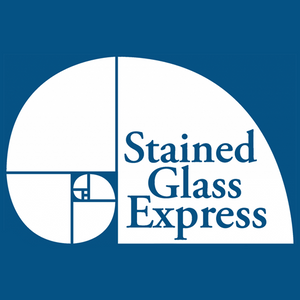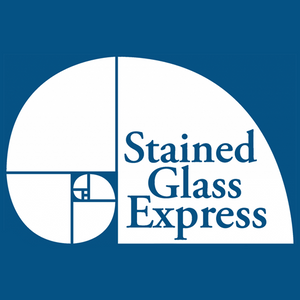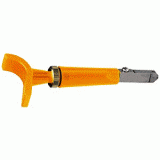This guide is based on document originally put out by Spectrum Glass in 2000.
This listing of frequently used terms and their brief descriptions includes those which apply to the products of all art glass manufacturers and not just those used in connection with Spectrum Glass. It is written in non-technical language for ease of understanding by the student and non-professional and is not intended to be completely authoritative or all inclusive.
Antique –
-
Full-Antique: Term applied to art glass produced by the historical mouth-blown cylinder method. The craftsman blows a glass cylinder, which is annealed and cooled. The cylinder is then scored lengthwise, separated, reheated and folded out into a flat sheet. Common characteristics include attractive linear striations and a very pristine surface.
-
Drawn-Antique: (also called semi-antique, machine-antique or new-antique) A simulated full-antique produced by the Vertical Draw method. The textural striations are mechanically applied. Quality is excellent and cost is less than full-antique. GNA (German New Antique) is a common example.
-
Scribed-Antique: A simulated full-antique produced by the Double Roll method. The linear striations are scribed into the hot glass surface. Quality is excellent and cost is considerably less than full-antique. Introduced by Spectrum Glass in 1996 under the trade name Artique.
Artique – (See
Scribed-Antique, above.)
Baroque - A machine made “reamy” glass, created by combining glasses of mismatched compositions. The different glasses “oppose” each other when they are stirred together, creating artistic 3-D swirls. A Spectrum exclusive.
Bent (or Slumped) Glass – Glass which has been heated in a kiln from room temperature to a temperature high enough to cause it to soften and slump (sag) into or over a mold. The finished item takes the shape of the mold.
Bevel – Cold glass (usually clear, thick plate) whose edges have been ground and polished to an angle other than 90 degrees. Transmitted light is refracted and a prism-like effect results. Bevels are available in a variety of sizes, shapes and geometric configurations (called “clusters”) for incorporation into leaded glass work.
Came – Channeled strips of lead, zinc or other metal used to bind glass pieces within a design. (See
Leaded Glass)
Cast Glass – A glass art medium in which glass is melted in, or melted and poured into a pre-shaped mold to create a finished project.
Cathedral Glass – Describes transparent glass that is monochromatic, i.e., single-color sheet glass, with smooth or textured surfaces.
Catspaw – (Single-roll-forming method) A surface texture resulting from chilling of hot glass on a cool table. The appearance is likened to the paw prints of a cat.
Confetti – Paper-thin elements of glass that can be incorporated into a fused or blown glass design. Also called “shards.”
Copper Foil – Thin, narrow strips of adhesive-backed copper tape used to wrap the edges of glass pieces that have been cut to fit a pattern. Once wrapped, solder is applied, bonding the glass pieces together. Assembling a stained glass project in this manner is called the “copper foil technique.” Louis Tiffany is credited with its development.
Crackle – (Blown cylinder method) the hot cylinder of glass is dipped in liquid causing radical, random fissures in the glass. The cylinder is then reheated and further blown to heal the surface fissures. Resulting surface resembles the texture of alligator skin.
Dalles – Thick (usually 1”) slabs of cathedral glass.
Dalle De Verre – An art glass medium in which dalles are broken into pieces with a carbon hammer and set in an epoxy base to adhere them in a decorative design. Dependent on large scale for best appearance, they are primarily used in architectural applications such as church walls.
Dichroic – A misnomer, but commonly used to describe glasses that have been coated with one or more ultra-thin crystalline layers of transparent metal oxides, designed to enhance reflections at specific wavelengths of light. The process occurs in a vacuum chamber at elevated temperatures. The resulting effects are striking and brilliant color reflections at varying angles of incidence.
Drapery Glass – Glass sheets with multiple dramatic folds, likened to those in hanging drapes.
Flashed – Glass of one color with a very thin layer of another glass color on one side. Flashed glass is often used for etched or sandblasted glass art. When sections of the thin color layer are removed, the other color shows through.
Flux – Chemical agent (liquid, gel or paste) used to facilitate the flow of solder and prevent formation of oxides during soldering.
Frit – Ground glass, ranging in particle size from gravel-like to a fine powder. Frit is sometimes used as a raw material in glass manufacture, and sometimes as a coloring agent or for decorative effect in hot glass crafts like blowing and fusing.
Fused Glass – Glass forms produced by placing different pieces of glass in contact with each other in an arranged design, then firing them in a kiln at a temperature high enough to fuse them into one piece of glass.
Fractures & Streamers – In the single-roll process (See
Sheet Forming Methods), the glass chips or shards (fractures) and/or glass string (streamers) are arranged on the casting table before the glass is poured, and the thus pressed into the glass sheet as it is formed.
Glob – (See
Nugget)
Glue-Chip – A texture created on the surface of cold glass by applying hot animal glue and allowing it to dry under controlled temperature and humidity conditions. As the glue dries and contracts, it chips the glass surface in a natural and attractive pattern, likened to frost on a window pane.
Gold Pink – Common name for colored glasses in the pink/cranberry/fuchsia range that require gold oxide as a coloring agent.
Hand-Cast Sheet Glass – Sheet glass produced by the single-roll method (See
Glass Sheet – Forming Methods).
Iridescent – A layer of metallic oxide is bonded to the hot glass surface just after sheet-forming, resulting in a colorful, shimmering effect.
Jewel – A piece of glass that has been cut and faceted or press-molded into a geometric shape like a jewel. Often incorporated into leaded glass artwork.
Leaded Glass – (1) Sheet glass pieces joined together with metal strips, usually made of lead, called “came”. Solder is applied to the joints of the came to bond the work together. (2) Glass containing lead as a raw material (as in “leaded crystal”).
Mosaic – A picture or decorative design made by setting small colored pieces of glass or ceramic material into a surface using cement or grout as a bonding agent.
Mottled Glass – (See
Ring Mottle)
Nugget – A small, irregularly shaped “glob” of glass, flat on the bottom, rounded across the top. Nuggets are made by literally dropping a small amount of molten glass onto a flat surface. Frequently called “globs,” they are often incorporated into leaded glass artwork.
Opal or Opalescent Glass – Said of any glass into which a material has been introduced at the raw materials stage (usually fluorine or phosphorus), which causes a degree of crystallization to occur, crating opacity in the glass. Reflected light is colorless, therefore white. The degree of opacity (and “whiteness”) is variable depending upon composition and temperatures used in the manufacturing process. White glass is commonly called “opal.”
- Solid Color Opalescent Glass: Glass which is both colored and crystallized, creating a single color sheet, more opaque than a cathedral. Sometimes called “opalized” glass.
-
Mixed Opalescent Glass: White glass (opal) is mixed with one or more other colors of glass to create a variegated, multi-colored sheet. Light transmission varies with composition. Also called “variegated opalescent,” sometimes “streaky.”
Painted Glass – Glass on which special paints (containing frit) have been applied in illustration or decorative pattern and then heated in a kiln to a temperature high enough to fuse the pigments permanently to the glass surface. The modern version of the original medieval “stained glass.”
Pate de Verre – An art glass medium in which powdered glass frits are spread in a decorative design, then fired in a kiln.
Reamy – Descriptive of full-antique glass with a wavy, irregular surface.
Ring Mottle Glass – An opalescent glass in which rates of crystal growth have been controlled to create ring-shaped areas of opacity. The effect is a visual surface mottling.
Ripple – A surface texture, often dramatic, consisting of linear or irregular ripples. Created naturally in some sheet-forming processes, imitated with an embossing roll in others.
Rondel – A mouth-blown piece of glass that has been spun into a circular shape, often irregular. Sometimes incorporated into leaded glass artworks. Machine-made facsimiles are common, called “pressed rondels.”
Seedy Glass – Glass in which air bubbles are entrapped. Air or gas is injected into the molten glass prior to forming the sheet.
Slump – (See
Bent Glass)
Solder – A fusible alloy, usually tin and lead, used to join metallic parts, or the act of applying it. Used to bond metals in both the leaded and copper foil techniques of stained glass work.
Stained Glass – Commonly used to describe any colored flat glass or any object made of such glass joined by metal strips. The term originally applied to the colored or clear flat glass cut to fit an artist’s design, on which details were painted with a brush or pigment. The glass pieces were then heated in a kiln or oven to bond the pigment to the glass surface. This firing makes the painted detail as durable and permanent as the glass itself. Most religious windows from medieval times until this century were executed in this manner and so the term came to be used first for any architectural application and then for any design in colored flat glass. It is now universally accepted as a convenient general term to define the art, the craft, and the industry.
Streaky Glass – Two or more cathedral glasses mixed together to create a multi-colored glass sheet. Some use this term also to describe Mixed Opalescent glass as defined above.
Stringer – Thin glass strings most commonly used in hot glass work.
Terazzo – A combination of marble, granite, onyx or glass chip in a binder of Portland cement or other resinous material. After curing, the surface is ground to expose the decorative chips.
Textured Glasses –
- Rolled textures: In rolled glasses (see definitions below) one of the forming rolls is embossed with a texture that is imprinted on the glass as the sheet is formed. This produces glass smooth on one side and textured on the other. Common examples are “hammered”, “granite” and “muffle.”
- Natural textures: Any textural effect created without mechanical influence or embossed rolls. Includes baroque and waterglass.
- Cold glass textures: This category includes glue chipping, etching, sandblasting and any other surface treatment performed on the cold glass sheet at room temperature.
Waterglass – A Spectrum Glass exclusive. A natural surface texture created by stretching the hot glass sheet while it is still in a malleable state. The result is gentle, rolling waves that resemble the surface of a lake or stream.
Wispy – A Spectrum Glass innovation. Mixed opalescent glass with only thin wisps of white, like lazy cloud trails.
Glass Manufacturing Terms
Annealing – Cooling the formed glass product at a controlled rate of temperature change for the purpose of relieving thermal stress. The appropriate cooling curve varies with glass type and formed shape, especially thickness. Directly related to glass cut ability.
Batch – The mixture of granular raw materials that is prepared and put into the melting furnace to create a given glass. The primary raw materials for clear glass are silica sand, soda ash and limestone. Cullet is often used.
Continuous Furnace – A glass melting furnace which is continuously full of molten glass. The introduction of batch (raw materials) into the furnace displaces existing molten glass and forces it out of the furnace and through the forehearth to the forming process. The process continues for the life of the furnace.
Cullet – Manufactured glass product that has been broken and crushed in preparation for recycling back through the furnaces. Some glass makers use cullet from other sources or from glass recyclers as a major raw material in their own batches.
Day Tank – A glass melting furnace that is designed to operate on a 24-hour cycle. The batch is added to an empty furnace at a rate that allows it to melt properly, until the furnace chamber is full. Then, after suitable “cookout” has occurred, the molten glass is used to make product. When the furnace is empty, the cycle is repeated.
Forehearth – A shallow chamber through which molten glass passes on its way from a continuous melting furnace to the forming process. The purpose of this chamber is to allow the temperature of the glass to drop from melting temperatures (about 2,700 degrees F) to forming temperatures (about 2,200 degrees F for 1/8”-thick sheet glass).
Lehr – An enclosed chamber through which formed glass products are carried for the purpose annealing.
Pot Furnace – A melting chamber in which one or more ceramic pots are placed. Batch is fed into the individual pots through ports in the chamber walls, and when melted, glass is ladled from the pots via the same ports. Each pot is fairly small. The pot furnace allows the melting of a number of different glass colors (as many as there are pots) at the same time, within a single melting chamber.
Glass Sheet-Forming Methods
Sheet glass types are often by delineated by how the sheet is formed. Thus people speak of “mouth-blown,” “double-rolled,” “drawn glass,” “float glass” and so on.
Blown Cylinder Method – (See
Full-Antique)
Single-Roll Method – Molten glass is poured onto a metal table and a single metal roll is used to flatten it into a sheet. Sometimes call “hand cast” sheet glass.
Double-Roll Method – Molten glass is passed between a pair of rotating metal rolls to form the sheet.
Vertical-Draw Method – Molten glass is pulled vertically through a slit in a large one-piece refractory block that is floating on the glass surface. The annealing lehr is mounted vertically over the draw chamber. Drawn glass is generally more pristine than rolled glass because its surface has remained untouched during forming.
Float Process – Molten glass is pulled from the forehearth atop a bath of molten tin. The process produces a perfectly smooth sheet of uniform thickness in high volume. The float process is used to produce virtually all common window glass today, thus the term “float glass.” Not used for art glass production.
Common Glass Coloring Agents
Opal (white) – Fluorine and a high alumina level to cause the fluorine to crystallize to opal
Clear – Sand with very low iron is required plus the absence of contaminants in other ingredients. Cobalt (blue producing) is often added to mask the greenish-brown tint that results from trace iron content.
Amber – Sulfur with carbon.
Lime Green – Chromium oxide.
Emerald Green – Chromium oxide with cobalt oxide and copper oxide.
Turquoise – Same basis as emerald with higher ration of cobalt oxide and copper oxide to chromium oxide.
Blue – Cobalt oxide and copper oxide. Different blue shades can be made with each of these used alone.
Purple – Manganese dioxide.
Yellow – Cadmium sulphide. Lead Compounds.
Orange – Cadmium sulphide and selenium.
Red – Cadmium sulphide with selenium in higher proportion than for orange. Selenium Oxide. Gold Chloride.
Violet – Nickel oxide.






























































